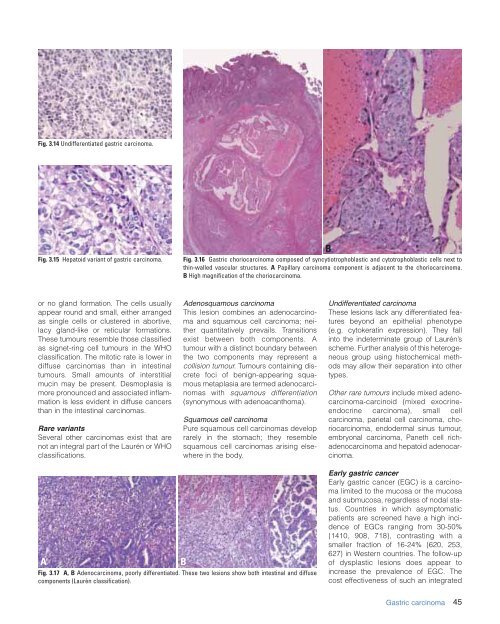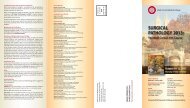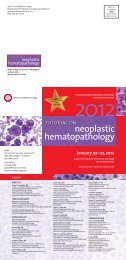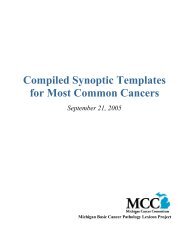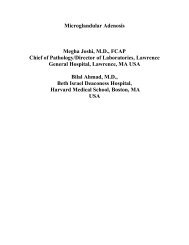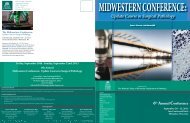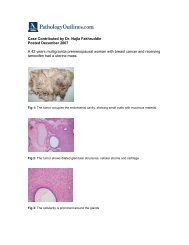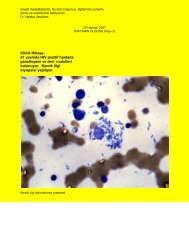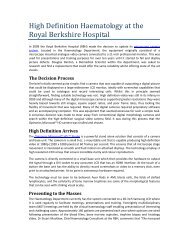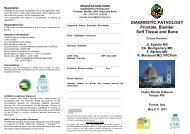CHAPTER 3 Tumours of the Stomach - Pathology Outlines
CHAPTER 3 Tumours of the Stomach - Pathology Outlines
CHAPTER 3 Tumours of the Stomach - Pathology Outlines
You also want an ePaper? Increase the reach of your titles
YUMPU automatically turns print PDFs into web optimized ePapers that Google loves.
Fig. 3.14 Undifferentiated gastric carcinoma.<br />
Fig. 3.15 Hepatoid variant <strong>of</strong> gastric carcinoma.<br />
Fig. 3.16 Gastric choriocarcinoma composed <strong>of</strong> syncytiotrophoblastic and cytotrophoblastic cells next to<br />
thin-walled vascular structures. A Papillary carcinoma component is adjacent to <strong>the</strong> choriocarcinoma.<br />
B High magnification <strong>of</strong> <strong>the</strong> choriocarcinoma.<br />
B<br />
or no gland formation. The cells usually<br />
appear round and small, ei<strong>the</strong>r arranged<br />
as single cells or clustered in abortive,<br />
lacy gland-like or reticular formations.<br />
These tumours resemble those classified<br />
as signet-ring cell tumours in <strong>the</strong> WHO<br />
classification. The mitotic rate is lower in<br />
diffuse carcinomas than in intestinal<br />
tumours. Small amounts <strong>of</strong> interstitial<br />
mucin may be present. Desmoplasia is<br />
more pronounced and associated inflammation<br />
is less evident in diffuse cancers<br />
than in <strong>the</strong> intestinal carcinomas.<br />
Rare variants<br />
Several o<strong>the</strong>r carcinomas exist that are<br />
not an integral part <strong>of</strong> <strong>the</strong> Laurén or WHO<br />
classifications.<br />
Adenosquamous carcinoma<br />
This lesion combines an adenocarcinoma<br />
and squamous cell carcinoma; nei<strong>the</strong>r<br />
quantitatively prevails. Transitions<br />
exist between both components. A<br />
tumour with a distinct boundary between<br />
<strong>the</strong> two components may represent a<br />
collision tumour. <strong>Tumours</strong> containing discrete<br />
foci <strong>of</strong> benign-appearing squamous<br />
metaplasia are termed adenocarcinomas<br />
with squamous differentiation<br />
(synonymous with adenoacanthoma).<br />
Squamous cell carcinoma<br />
Pure squamous cell carcinomas develop<br />
rarely in <strong>the</strong> stomach; <strong>the</strong>y resemble<br />
squamous cell carcinomas arising elsewhere<br />
in <strong>the</strong> body.<br />
Undifferentiated carcinoma<br />
These lesions lack any differentiated features<br />
beyond an epi<strong>the</strong>lial phenotype<br />
(e.g. cytokeratin expression). They fall<br />
into <strong>the</strong> indeterminate group <strong>of</strong> Laurén’s<br />
scheme. Fur<strong>the</strong>r analysis <strong>of</strong> this heterogeneous<br />
group using histochemical methods<br />
may allow <strong>the</strong>ir separation into o<strong>the</strong>r<br />
types.<br />
O<strong>the</strong>r rare tumours include mixed adenocarcinoma-carcinoid<br />
(mixed exocrineendocrine<br />
carcinoma), small cell<br />
carcinoma, parietal cell carcinoma, choriocarcinoma,<br />
endodermal sinus tumour,<br />
embryonal carcinoma, Paneth cell richadenocarcinoma<br />
and hepatoid adenocarcinoma.<br />
A<br />
Fig. 3.17 A, B Adenocarcinoma, poorly differentiated. These two lesions show both intestinal and diffuse<br />
components (Laurén classification).<br />
B<br />
Early gastric cancer<br />
Early gastric cancer (EGC) is a carcinoma<br />
limited to <strong>the</strong> mucosa or <strong>the</strong> mucosa<br />
and submucosa, regardless <strong>of</strong> nodal status.<br />
Countries in which asymptomatic<br />
patients are screened have a high incidence<br />
<strong>of</strong> EGCs ranging from 30-50%<br />
{1410, 908, 718}, contrasting with a<br />
smaller fraction <strong>of</strong> 16-24% {620, 253,<br />
627} in Western countries. The follow-up<br />
<strong>of</strong> dysplastic lesions does appear to<br />
increase <strong>the</strong> prevalence <strong>of</strong> EGC. The<br />
cost effectiveness <strong>of</strong> such an integrated<br />
Gastric carcinoma<br />
45


